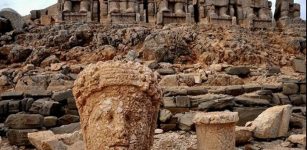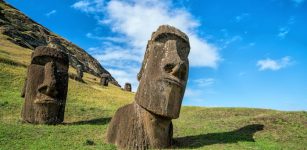Hird – Viking Warriors And Professional Body Guards Prepared To Die For Their Leader
Ellen Lloyd - AncientPages.com - An influential Viking chief had many enemies lurking everywhere. To stay in power, he had to be protected. A hird consisted of hired professional warriors who guaranteed their leader's safety day and night.
They were greatly rewarded for their services and lived a life many young men could only envy.
Becoming a Hirdman was an honor. Credit: Adobe Stock - fotokvadrat
Many young Vikings dreamt about an adventurous life, and being chosen to a hird was a great honor. A young Viking had to distinguish himself because Viking chiefs selected the most skilled warriors and only those from influential families.
Being good in battle was no guarantee that a Viking could serve in a hird.
The word hird itself stems from the Anglo-Saxon word hîred, which means a 'family' or 'household.'
Hirdman was a member of a Hird household family. Viking leaders had warriors in service from ancient times.
At the beginning of the Viking Age, a hird was like a war band, but around the time of the early Viking voyages, the term referred to a more unified group of bodyguards who traveled with their leader and protected him. A hird could be made up of 60 Viking warriors. Although any free man could assemble a hird, the truth is that only the most powerful chiefs and kings could afford the luxury of personal bodyguards.
Norse warriors did not fight for free. Their services were costly, and their payment came in gifts such as gold and silver, clothes, and weapons.
Warriors also needed proper accommodation, food, and drink to protect their leader all around the clock.
The leader fought for victory in a battle, and the warriors fought for the leader.
Becoming a member of a hird meant that warriors swore an oath to fight and defend their leader at any time.
They also had to hand over plundered treasures to their leader, who gave them some of the booties. Any member of the hird had to avenge their leader's death if necessary.
Bonds between hirdmen were strong and they saw themselves as a warrior brotherhood. Credit: Adobe Stock - Nejron Photo
Of course, Viking chiefs did more than engage in battles. A hird had to follow their leader to meetings with other chiefs and participate in many journeys. In those days, it was undoubtedly a desirable profession.
Once a Hirdman finished his duty, he was given a bit of land and property from the leader he had served faithfully.
A hird should not be confused with the Varangian Guard, which also consisted of hired professional Viking warriors. As we discussed on Ancient Pages before, However, the Varangian Guard represented the elite heavy infantry regiment of the Roman ('Byzantine') Empire from AD 988 AD to around 1404 AD. the Varangian Guard also employed warriors who successfully conquered territories.
It's also worth mentioning that members of a hird shared a unique and strong bond. They perceived themselves as brothers, just like the fearsome Jomsvikings – a mysterious Scandinavian warrior-brotherhood.
Updated on October 1, 2022
Written by - Ellen Lloyd – AncientPages.com
Copyright © AncientPages.com All rights reserved. This material may not be published, broadcast, rewritten or redistributed in whole or part without the express written permission of AncientPages.com
Expand for referencesReferences:
Anette Tamm - Vikingar: kring hem och härd
Lars Magnar Enoksen - Vikingarnas stridskonst
Hans H Lundqvist - Vikingarnas ursprung
More From Ancient Pages
-
 Paleolithic Standing Bird Figurine – East Asian 3-D Art – Recovered From Refuse Heap
Archaeology | Jun 23, 2020
Paleolithic Standing Bird Figurine – East Asian 3-D Art – Recovered From Refuse Heap
Archaeology | Jun 23, 2020 -
 Ancient Tombs Of The Nobles In The Valley Of The Queens
Featured Stories | Oct 23, 2016
Ancient Tombs Of The Nobles In The Valley Of The Queens
Featured Stories | Oct 23, 2016 -
 Controversial Atacama Skeleton Is Not An Alien – DNA Study Reveals
Archaeology | Mar 23, 2018
Controversial Atacama Skeleton Is Not An Alien – DNA Study Reveals
Archaeology | Mar 23, 2018 -
 Tiny Paper Scraps From ‘Queen Anne’s Revenge’ Shed Light On Reading Habits Of Blackbeard’s Pirates
Archaeology | Jan 7, 2018
Tiny Paper Scraps From ‘Queen Anne’s Revenge’ Shed Light On Reading Habits Of Blackbeard’s Pirates
Archaeology | Jan 7, 2018 -
 Denisovans In The Altai Mountains: A Hominin Group That Interbred With Modern Humans
Evolution | Nov 11, 2024
Denisovans In The Altai Mountains: A Hominin Group That Interbred With Modern Humans
Evolution | Nov 11, 2024 -
 Kommagene Civilization And The Ancient City Of Perge
Civilizations | Jan 25, 2016
Kommagene Civilization And The Ancient City Of Perge
Civilizations | Jan 25, 2016 -
 New Discovery: Fragments Of Pyramid Dated To 13th Dynasty Discovered In Dahshur Necropolis
Archaeology | Apr 3, 2017
New Discovery: Fragments Of Pyramid Dated To 13th Dynasty Discovered In Dahshur Necropolis
Archaeology | Apr 3, 2017 -
 Tlayococ Cave’s Hidden Chamber Filled With Rare Pre-Hispanic Artifacts Left By The Extinct Tlacotepehua People
Archaeology | Apr 23, 2025
Tlayococ Cave’s Hidden Chamber Filled With Rare Pre-Hispanic Artifacts Left By The Extinct Tlacotepehua People
Archaeology | Apr 23, 2025 -
 2000-Year-Old Antikythera Mechanism – Experts Recreate A Mechanical Cosmos For The World’s First Computer
Ancient Technology | Mar 15, 2021
2000-Year-Old Antikythera Mechanism – Experts Recreate A Mechanical Cosmos For The World’s First Computer
Ancient Technology | Mar 15, 2021 -
 Unknown Ancient Structures Discovered At Machu Picchu By LIDAR
Archaeology | Mar 29, 2022
Unknown Ancient Structures Discovered At Machu Picchu By LIDAR
Archaeology | Mar 29, 2022 -
 Mysterious Gigantic Jars Of Unknown Origin Discovered Worldwide
Artifacts | Dec 27, 2018
Mysterious Gigantic Jars Of Unknown Origin Discovered Worldwide
Artifacts | Dec 27, 2018 -
 New Moai Statue Found On Easter Island
Archaeology | Feb 28, 2023
New Moai Statue Found On Easter Island
Archaeology | Feb 28, 2023 -
 Colossi Of Memnon Guarded Temple Of Pharaoh Amenhotep III And Curious Sound Phenomenon
Featured Stories | Feb 2, 2021
Colossi Of Memnon Guarded Temple Of Pharaoh Amenhotep III And Curious Sound Phenomenon
Featured Stories | Feb 2, 2021 -
 On This Day In History: ‘Principia Mathematica’ Monumental Work Published By Isaac Newton – On July 5, 1687
News | Jul 5, 2016
On This Day In History: ‘Principia Mathematica’ Monumental Work Published By Isaac Newton – On July 5, 1687
News | Jul 5, 2016 -
 20 Mummies Discovered In Greco-Roman Tombs In Aswan, Egypt
Archaeology | Jan 21, 2022
20 Mummies Discovered In Greco-Roman Tombs In Aswan, Egypt
Archaeology | Jan 21, 2022 -
 Gold Treasures Of Ancient King Discovered In North America Create Historical Problems
Ancient Mysteries | Jun 29, 2018
Gold Treasures Of Ancient King Discovered In North America Create Historical Problems
Ancient Mysteries | Jun 29, 2018 -
 Runic Inscription On The Forsa Ring Is Not What We First Thought – Scientists Say
Archaeology | Aug 15, 2024
Runic Inscription On The Forsa Ring Is Not What We First Thought – Scientists Say
Archaeology | Aug 15, 2024 -
 Strange Ancient Artifacts And Foreigners Who Were Not Meant To Be In North America
Ancient Mysteries | Mar 16, 2020
Strange Ancient Artifacts And Foreigners Who Were Not Meant To Be In North America
Ancient Mysteries | Mar 16, 2020 -
 3,500-Year-Old Cuneiform Clay Tablets With Hittites’ Texts – Soon To Be Accessible Online
News | Oct 15, 2020
3,500-Year-Old Cuneiform Clay Tablets With Hittites’ Texts – Soon To Be Accessible Online
News | Oct 15, 2020 -
 Mysterious Old Ship With No Crew Reaches The Canadian Coast
Featured Stories | Jul 25, 2024
Mysterious Old Ship With No Crew Reaches The Canadian Coast
Featured Stories | Jul 25, 2024


